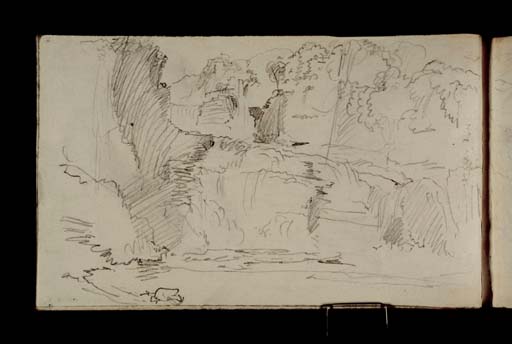Joseph Mallord William Turner Falls of Clyde: Corra Linn 1834
Image 1 of 2
Joseph Mallord William Turner,
Falls of Clyde: Corra Linn
1834
Joseph Mallord William Turner 1775–1851
Folio 2 verso:
Falls of Clyde: Corra Linn 1834
D26262
Turner Bequest CCLXIX 2a
Turner Bequest CCLXIX 2a
Pencil on off-white wove paper, 113 x 190 mm
Accepted by the nation as part of the Turner Bequest 1856
References
1909
A.J. Finberg, A Complete Inventory of the Drawings of the Turner Bequest, London 1909, vol.II, p.864, CCLXIX 2a, as ‘Falls of Clyde: Bonnington Linn.’.
1984
Martin Butlin and Evelyn Joll, The Paintings of J.M.W. Turner, revised ed., New Haven and London 1984, p.300.
1990
Dr David Wallace-Hadrill and Janet Carolan, ‘Turner’s Sketches North of Stirling’, Turner Studies: His Art and Epoch 1775 – 1851, Vol.10 No.1, Summer 1990, p.12.
1974
Martin Butlin, Andrew Wilton and John Gage, Turner 1775–1851, exhibition catalogue, Royal Academy, London 1974, p.126 under no.451.
1990
Frank Milner, J.M.W. Turner: Paintings in Merseyside Collections: Walker Art Gallery; Sudley Art Gallery; Williamson Art Gallery; Lady Lever Art Gallery; Liverpool University Art Gallery, Liverpool 1990, p.68.
The sketch on this page appears to continue on folio 3 (D26263) making a double-page spread of a view that is repeated across folios 3 verso–4 and 4 verso–5 (D26264–D26265; D26266–D26267). Finberg’s suggestion that Bonnington Linn is depicted on the present page and Corra Linn on folio 3 is therefore impossible.1 The two waterfalls (or ‘linns’) are two of the three ‘Falls of Clyde’ (see folio 1 verso; D26260).
It can be difficult to distinguish between the two waterfalls on the basis of sketches and other artworks as they look different depending on how much water is flowing over the falls, and they both change in appearance when seen from different angles and vantage points. There are, however, two features that link the sketches across folios 1 verso–6 verso (D26260–D26270), and help to identify them as Corra Linn. Both features are clearly visible in the sketch across folios 4 verso–5 (D26266–D26267), which depicts a similar view to the present drawing. At the top left of that sketch is the small ruin of Corra Castle, a fortified cliff-top tower (see folios 5 verso–6 verso; D26268–D26269), and at the right is a set of steep steps which must be those that Lady Mary Ross had cut into the rock as a way down to the foot of the waterfall around 1817.2
Corra Castle may be depicted above the waterfall at the very top of the present page, while the steps are indicated at the right of folio 3 (D26263). The vantage point for this series of sketches is therefore the eastern side of the Clyde River, just downstream of Corra Linn above what is often described as a natural amphitheatre. Nearby is the Bonnington Pavilion, built by Sir John Carmichael of Bonnington, probably in 1708, to provide a picturesque viewing station for Corra Linn. The present page provides Turner’s most carefully executed sketch of the rock-walled amphitheatre with the foaming waterfall, evidently not in full-force, at the centre of the page.
For further information about Turner’s visit to the Falls of Clyde and his sketches of the waterfalls, see folio 1 verso (D26260).
Thomas Ardill
September 2010
Finberg 1909, II, p.864. Wallace-Hadrill followed this suggestion in his unpublished notes (David Wallace-Hadrill, ‘Upper Clyde’, [circa 1991], Tate catalogue files), though he had been, like several other writers, more cautious in a published article where he labelled this and other sketches simply ‘the Falls of Clyde’ (Wallace-Hadrill and Carolan 1990, p.12). The sketch is labelled ‘Falls of Clyde’ in the following publications: Butlin and Joll 1984, p.300; Butlin, Wilton and Gage 1974, p.126; and Milner 1990, p.68.
How to cite
Thomas Ardill, ‘Falls of Clyde: Corra Linn 1834 by Joseph Mallord William Turner’, catalogue entry, September 2010, in David Blayney Brown (ed.), J.M.W. Turner: Sketchbooks, Drawings and Watercolours, Tate Research Publication, December 2012, https://www


